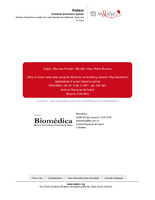Please use this identifier to cite or link to this item:
http://sgc.anlis.gob.ar/handle/123456789/365| Title: | Utility of nitrate reductase assay for detection of multidrug-resistant Mycobacterium tuberculosis in a low resource setting | Other Titles: | Utilidad del ensayo de nitrato reductasa en la detección de Mycobacterium tuberculosis multirresistente en caso de recursos limitados | Authors: | López, Marcela Alvarez, Claudia Imaz, María Susana |
Keywords: | Mycobacterium tuberculosis;Resistencia a Medicamentos;Pruebas de Sensibilidad Microbiana;Métodos;Nitrato-Reductasa | Issue Date: | 2011 | Abstract: | Introduction.The performance of a drug susceptibility test may change when moving from the research stage to implementation on a population level in actual public health practice. Objective.The performance of a rapid drug susceptibility test was described for detecting multidrug-resistant Mycobacterium tuberculosis when implemented in the routine workflow of a low-resource reference laboratory. Materials and methods.A prospective study was done comparing the performance of the nitrate reductase assay with the conventional proportion method for rifampicin and isoniazid on 364 isolates were obtained from multidrug-resistant tuberculosis risk patients referred from diffrent Colombian laboratories. Results.When compared with the proportion method, the nitrate reductase assay sensitivity was 86.8% and 84.9% for rifampicin and isoniazid, respectively, whereas nitrate reductase assay specificity was 100% for isoniazid and rifampicin. Nitrate reductase assay sensitivity was significantly higher when the age of isolate was less than 70 days. A sensitivity of 94.4% dropped to 78.1% for rifampicin resistance for fresh and old isolates, respectively (Fisher exact test, p=0.05). For isoniazid resistance using fresh and old isolates, 94.7% vs.74.3% sensitivities, were achieved (chi square test, p=0.03). The proportion of nitrate reductase assay ambiguous results was significantly higher in multidrug-resistant than in non-multidrug-resistant isolates (17.6% vs. 4.0%, chi square test, p<0.005). Conclusions.The nitrate reductase assay demonstrated provided reliable results for antibiotic resistance. However, using old cultures leds to a higher proportion of false sensitive results; furthermore, the nitrate reductase assay capability to detect multidrug-resistant tuberculosis decreased due to a higher proportion of non-interpretable results. |
Description: | Fil: López, Marcela. ANLIS Dr.C.G.Malbrán. Instituto Nacional de Enfermedades Respiratorias; Argentina. Fil: Alvarez, Claudia. ANLIS Dr.C.G.Malbrán. Instituto Nacional de Enfermedades Respiratorias; Argentina. Fil: Imaz, María Susana. ANLIS Dr.C.G.Malbrán. Instituto Nacional de Enfermedades Respiratorias; Argentina. |
URI: | http://www.revistabiomedica.org/index.php/biomedica/article/view/300/573 http://sgc.anlis.gob.ar/handle/123456789/365 |
ISSN: | 0120-4157 | Rights: | info:eu-repo/semantics/openAccess |
| Appears in Collections: | snrd Publicaciones INER |
Files in This Item:
| File | Description | Size | Format | |
|---|---|---|---|---|
| Biomédica,2011,31(2),258–263.pdf | Artículo en inglés | 175.69 kB | Adobe PDF |  View/Open |
Page view(s)
145
checked on Jan 2, 2026
Download(s)
21
checked on Jan 2, 2026
Google ScholarTM
Check
Items in DSpace are protected by copyright, with all rights reserved, unless otherwise indicated.

